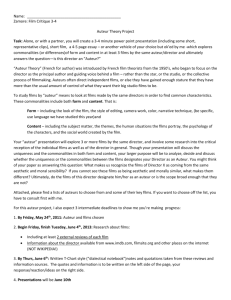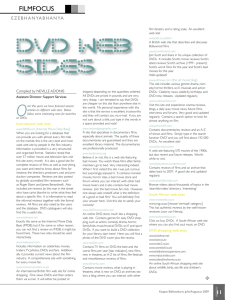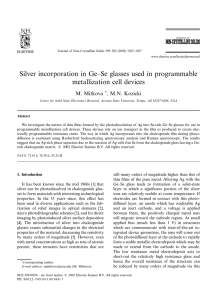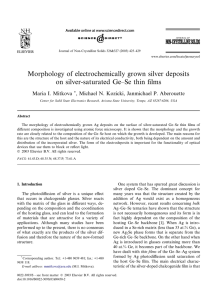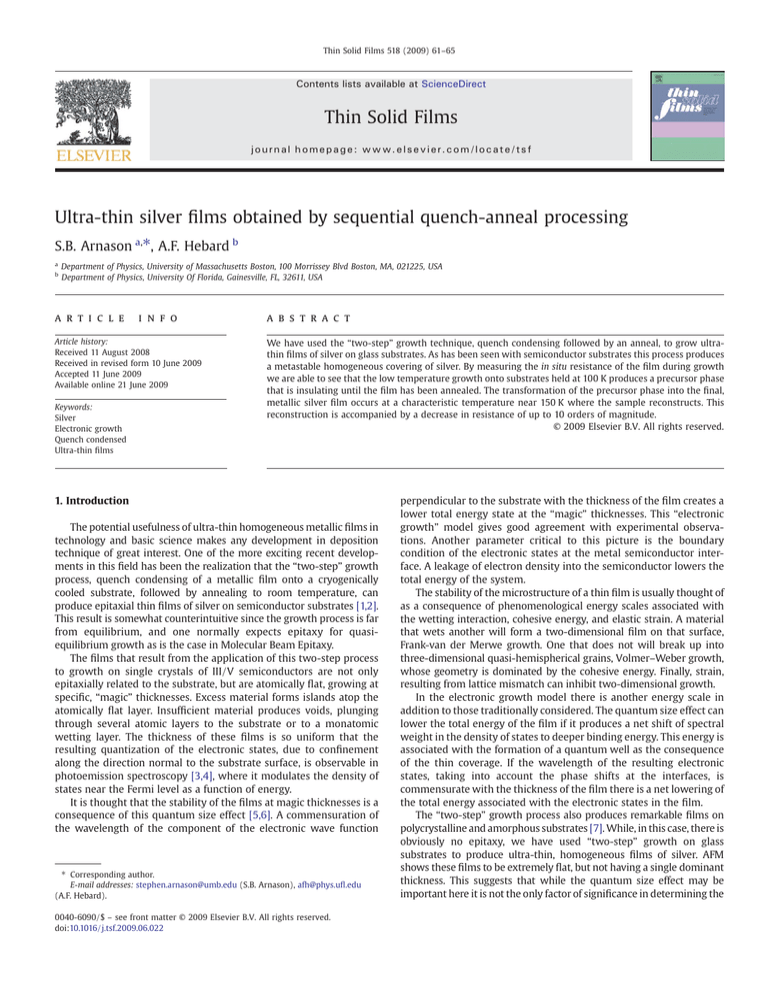
Thin Solid Films 518 (2009) 61–65
Contents lists available at ScienceDirect
Thin Solid Films
j o u r n a l h o m e p a g e : w w w. e l s e v i e r. c o m / l o c a t e / t s f
Ultra-thin silver films obtained by sequential quench-anneal processing
S.B. Arnason a,⁎, A.F. Hebard b
a
b
Department of Physics, University of Massachusetts Boston, 100 Morrissey Blvd Boston, MA, 021225, USA
Department of Physics, University Of Florida, Gainesville, FL, 32611, USA
a r t i c l e
i n f o
Article history:
Received 11 August 2008
Received in revised form 10 June 2009
Accepted 11 June 2009
Available online 21 June 2009
Keywords:
Silver
Electronic growth
Quench condensed
Ultra-thin films
a b s t r a c t
We have used the “two-step” growth technique, quench condensing followed by an anneal, to grow ultrathin films of silver on glass substrates. As has been seen with semiconductor substrates this process produces
a metastable homogeneous covering of silver. By measuring the in situ resistance of the film during growth
we are able to see that the low temperature growth onto substrates held at 100 K produces a precursor phase
that is insulating until the film has been annealed. The transformation of the precursor phase into the final,
metallic silver film occurs at a characteristic temperature near 150 K where the sample reconstructs. This
reconstruction is accompanied by a decrease in resistance of up to 10 orders of magnitude.
© 2009 Elsevier B.V. All rights reserved.
1. Introduction
The potential usefulness of ultra-thin homogeneous metallic films in
technology and basic science makes any development in deposition
technique of great interest. One of the more exciting recent developments in this field has been the realization that the “two-step” growth
process, quench condensing of a metallic film onto a cryogenically
cooled substrate, followed by annealing to room temperature, can
produce epitaxial thin films of silver on semiconductor substrates [1,2].
This result is somewhat counterintuitive since the growth process is far
from equilibrium, and one normally expects epitaxy for quasiequilibrium growth as is the case in Molecular Beam Epitaxy.
The films that result from the application of this two-step process
to growth on single crystals of III/V semiconductors are not only
epitaxially related to the substrate, but are atomically flat, growing at
specific, “magic” thicknesses. Excess material forms islands atop the
atomically flat layer. Insufficient material produces voids, plunging
through several atomic layers to the substrate or to a monatomic
wetting layer. The thickness of these films is so uniform that the
resulting quantization of the electronic states, due to confinement
along the direction normal to the substrate surface, is observable in
photoemission spectroscopy [3,4], where it modulates the density of
states near the Fermi level as a function of energy.
It is thought that the stability of the films at magic thicknesses is a
consequence of this quantum size effect [5,6]. A commensuration of
the wavelength of the component of the electronic wave function
⁎ Corresponding author.
E-mail addresses: stephen.arnason@umb.edu (S.B. Arnason), afh@phys.ufl.edu
(A.F. Hebard).
0040-6090/$ – see front matter © 2009 Elsevier B.V. All rights reserved.
doi:10.1016/j.tsf.2009.06.022
perpendicular to the substrate with the thickness of the film creates a
lower total energy state at the “magic” thicknesses. This “electronic
growth” model gives good agreement with experimental observations. Another parameter critical to this picture is the boundary
condition of the electronic states at the metal semiconductor interface. A leakage of electron density into the semiconductor lowers the
total energy of the system.
The stability of the microstructure of a thin film is usually thought of
as a consequence of phenomenological energy scales associated with
the wetting interaction, cohesive energy, and elastic strain. A material
that wets another will form a two-dimensional film on that surface,
Frank-van der Merwe growth. One that does not will break up into
three-dimensional quasi-hemispherical grains, Volmer–Weber growth,
whose geometry is dominated by the cohesive energy. Finally, strain,
resulting from lattice mismatch can inhibit two-dimensional growth.
In the electronic growth model there is another energy scale in
addition to those traditionally considered. The quantum size effect can
lower the total energy of the film if it produces a net shift of spectral
weight in the density of states to deeper binding energy. This energy is
associated with the formation of a quantum well as the consequence
of the thin coverage. If the wavelength of the resulting electronic
states, taking into account the phase shifts at the interfaces, is
commensurate with the thickness of the film there is a net lowering of
the total energy associated with the electronic states in the film.
The “two-step” growth process also produces remarkable films on
polycrystalline and amorphous substrates [7]. While, in this case, there is
obviously no epitaxy, we have used “two-step” growth on glass
substrates to produce ultra-thin, homogeneous films of silver. AFM
shows these films to be extremely flat, but not having a single dominant
thickness. This suggests that while the quantum size effect may be
important here it is not the only factor of significance in determining the
62
S.B. Arnason, A.F. Hebard / Thin Solid Films 518 (2009) 61–65
final microstructure. Importantly, this also suggests that much of the
uniqueness in two-step growth may be a consequence of the quenched
kinetics rather than the quantum energies involved.
This idea that there is a kinetic constraint on the microstructure is
also supported by the metastability of the two-step films. Our films on
glass are stable at room temperature but reconstruct into isolated
three-dimensional droplets at about 323 K, the agglomeration
temperature, Ta. Shih et al. sees a similar reconstruction for their
films on GaAs, but at 670 K [8]. It is likely that the electronic growth
mechanism should be thought of as an energy barrier between the
homogeneous ultra-thin films and the thermodynamically stable
structures that growth techniques closer to equilibrium produce.
Clearly the energy associated with the quantum well state is
important, but these films are fundamentally metastable. It is only
because we have traveled along a kinetically constrained path of
growth that we are able to find this local energy minimum.
Given the importance of the growth kinetics it is necessary that we
understand the physics of the low temperature phase if we are to
understand two-step growth in detail. To date the work in this field
has primarily focused on the final product, the unique film that results
from “two-step” growth. This paper presents results on the precursor
phase and, equally importantly, about the transformation that it
undergoes during the annealing process. To accomplish this we
measure the in situ resistivity throughout the entire growth. This gives
us a measurement of a property of the material which can be tracked
through the actual transition. We then compare the resulting material
to films grown without constrained kinetics by measuring the
resistivity as a function of temperature, ex situ.
frame. At 100 K there is a steady monotonic decrease of resistance
with increasing thickness, suggesting that the morphology of the film
is consistent throughout the growth. At a thickness of about 160 Å we
doubled the growth rate and there is a noticeable change is the slope
of resistance as a function of thickness but the dependence is still
monotonic. This is to be contrasted with room temperature growth
where the resistance initially varies exponentially with thickness,
changing to a power law at the percolation threshold, and finally
crossing over to 1/(thickness) dependence when the film becomes
homogeneous [9]. The room temperature growth occurs initially as
nucleation of isolated clusters, which grow by the addition of atoms
from the arriving flux that diffuse over the surface. The sudden drop in
resistance occurs when the islands reach a density equivalent to the
percolation threshold at a coverage of about 18 nm. Finally, at thick
enough coverage, the film becomes effectively homogeneous within
the plane of the substrate and the resistivity scales with the inverse of
the thickness, as one would expect from simple geometric considerations within a Fuchs–Sondheimer picture [10].
If we terminate the growth of a quench condensed film at a
coverage of 20 to 60 Å and measure the resistance during the anneal to
room temperature we see a dramatic change of resistance at a
characteristic temperature of about 150 K, henceforth referred to as Ttr
(see Fig. 2). Below Ttr the sample is an insulator with activated
conduction. In this region the resistance is reversible as a function of
temperature. When the sample warms to Ttr, an irreversible
reconstruction of the film begins. As a result of this reconstruction,
the sample transforms from an ultra-thin insulator into an ultra-thin
homogeneous metallic film. Quenching of the reconstruction can be
achieved by rapidly cooling the sample before it has completely
2. Experimental details
Our films are grown in high vacuum, base pressure 2 × 10− 8 Torr.
The silver, 99.999% purity, is evaporated from an alumina crucible at a
rate of approximately 1 Å per minute. The substrate is cooled by
thermally anchoring it to a liquid nitrogen reservoir. Its temperature is
measured by a type J thermocouple mounted on the surface of a
second substrate in an attempt to mimic the imperfect thermal
contact. The temperature during deposition is approximately 100 K,
though variation of 1 to 2 K due to radiative heating by the silver
source is observable. To minimize cryopumping of contamination onto
the substrate surface before deposition the substrate was kept at room
temperature till the source was stabilized at the desired temperature
and then quickly cooled to growth temperature, ∼ 5 min.
The thin films are deposited through a shadow mask of a standard
“Hall Bar” onto a substrate with pre-deposited gold\chromium
electrodes. The resistance is measured by applying a voltage and
measuring the resulting current with an electrometer, with remote
voltage sensing on a second set of contacts so as to minimize the
effects of contact resistance. The sign of the applied voltage is
alternated and averaged to compensate for any DC offsets. The
frequency of voltage reversal is chosen so that we can ignore currents
due to capacitative charging which are significant when the samples
are highly resistive. As the sample resistance decreases the excitation
voltage is varied through a range from 2 V to 2 mV during the
measurement to keep a good signal to noise ratio.
After growth the resistivity as a function of temperature of the
films is measured ex situ in a liquid Helium cryostat. Here the
measurements are made with an AC resistance bridge at 17 Hz using
an excitation voltage of 2 mV. The measurement temperatures ranged
from 2 to 300 K.
3. Results
Fig. 1 shows the resistance as a function of coverage (the mass of
deposited material per unit area, normalized by density) for samples
as they grow at 100 K, lower frame, and at room temperature, upper
Fig. 1. Sheet resistance as a function of thickness during growth for a quench condensed
film, lower frame, and a film grown at room temperature, upper frame.
S.B. Arnason, A.F. Hebard / Thin Solid Films 518 (2009) 61–65
63
Fig. 2. Sheet resistance as a function of temperature as a nominal coverage of 4.3 nm of
quench condensed Ag anneals to room temperature, measured in situ.
reconstructed to its final state (see Fig. 3). If we perform this quench
before the sample has annealed to a sheet resistance lower than
∼ 20 kΩ, then the low temperature resistivity as a function of
temperature is activated. If we arrest the anneal after the sheet
resistance has fallen below this value, the temperature dependence is
metallic.
Allowing the sample to anneal to room temperature results in a
film which is metastable, showing a reversible dependence of
resistivity on temperature as long as the temperature does not go
above Ta, where the sample will irreversibly reconstruct into isolated
hemispherical islands of silver. For our samples on glass this
temperature is typically ∼350 K.
The morphology of the films that are raised above this second
characteristic temperature, as measured by atomic force microscopy,
is equivalent to that of films grown at room temperature whose
growth was terminated at the same coverage, showing isolated grains
of silver. The two-step films that are kept at room temperature show a
homogeneous coverage with no grain structure visible at length scales
within the resolution of the instrument [7]. These films are also
relatively stable in an inert atmosphere, showing no change in the
resistivity as a function of time over several weeks.
Further insight into the microstructure can be gleaned from the ex
situ measurement of resistivity as a function of temperature. Fig. 4
shows resistivity as a function of temperature for three films of silver;
a two-step film, a film grown at room temperature where the growth
Fig. 4. Resistivity as a function of temperature for three silver films grown on glass
substrates, measured ex situ, after growth. The bottommost set of data, triangular
markers, is for a film grown at room temperature to a thickness where it has become
homogeneous. The middle set of data, square markers, is for a film grown at room
temperature, with the growth terminated during the percolation of the film. The
topmost set of data, circular markers, shows resistivity as a function of temperature for
5 nm of silver grown on glass by the two-step process.
has been terminated in the percolative, scaling regime, and a room
temperature grown film that has been grown to the point of showing
resistivity scaling with inverse thickness. While all three films show
relatively high residual resistivity, indicating that they are disordered,
the percolating silver film also shows an enhanced temperature
dependence of resistivity. This enhanced temperature dependence is a
consequence of the conversion of the resistance as a function of
temperature data to resistivity by scaling it with the effective
thickness of the film, but not taking into account the inhomogeneous
morphology of the percolating cluster. The resistivity for the
percolating film can be mapped onto that of the homogeneous film
by dividing the data by a single geometric factor, a factor that is a
measure of the fractal geometry of the cluster [9]. Thus, the
enhancement of the temperature dependence of resistivity away
from that of bulk silver can be used to measure the geometric
inhomogeneity of the system. The data for the two-step film has
enhanced residual resistivity but temperature dependence indistinguishable from the homogeneous film. This observation indicates that
the resistivity can be used as a measure of sample homogeneity and
that the two-step films are extremely homogeneous.
4. Discussion
Fig. 3. Sheet resistance as a function of temperature as a nominal coverage of 2.8 nm of
quench condensed Ag anneals to room temperature, measured in situ.
Clearly the most compelling data presented in this paper is that of
the resistive signature of the morphological reconstruction shown in
Fig. 2. The data shown here is typical. All two-step films in the
thickness range studied show this transition. There is always a
characteristic temperature at which it begins, but as the samples
become thicker the breadth of the transition in temperature increases.
The existence of this sharp transition suggests that there is a very
specific energy barrier that must be overcome for the films to
reconstruct. Besides the sharpness of the transition, the magnitude
of the change is also quite striking. A change of resistance of ten orders
of magnitude indicates that there is a significant change in the nature
64
S.B. Arnason, A.F. Hebard / Thin Solid Films 518 (2009) 61–65
of the silver film. The precursor phase, which anneals into the ultrathin metallic silver film, is a good insulator. The final state is a good
metal.
The existence of this specific relatively low energy scale for
transformation is quite surprising. All of the characteristic energy
scales associated with the mobility of silver are significantly higher.
For example the activation energy for grain growth, which is similar in
magnitude to the energy scale associated with surface diffusion, has
been found to be on the order of 530 meV [11]. The lowest energy
scales that we are aware of have been identified in Molecular
Dynamics simulations of diffusion processes on the (111) facets of
small silver clusters with activation energies as low as 70 meV [12].
Even this is several times larger than the 13 meV that is equivalent to
150 K.
A possible model of this transition is that islands of metallic silver
are nucleating inside of a host of the insulating precursor. The
crossover sheet resistance corresponds to a percolation of these
islands into a contiguous backbone that spans the sample. This picture
of the reconstruction is consistent with a model of the precursor phase
due to Rinderer et al. [13,14]. They propose that the low temperature
low-coverage phase is composed of an amorphous agglomeration of
singlet dimers of the metal atoms. These molecules of metal atoms are
metastable and have an activation barrier that prevents them from
joining with other dimers or atoms to form larger clusters. Though a
little vague on the details this model offers a plausible explanation of
the insulating state.
There is also support for a highly disordered low temperature
phase from in situ x-ray diffraction data taken on films while still in a
specially designed growth chamber [15]. At 87 K films show no (111)
reflections but at 188 K these are present. Analysis using Sherrer's
formula, which relates the width of the x-ray diffraction peaks to the
average grain size, shows no discernible crystallites at 77 K but the
onset of crystallites whose dimensions are smaller than the film
thickness appears after annealing to 150 K.
As far as we know, low temperature, high resolution STM studies
have not been made to characterize the microstructure of the
precursor phase in silver. Published work for films of Gold on highly
oriented pyrolitic graphite show a homogeneous coverage up to a
1.6 nm thickness, but the formation of islands for a thickness of 1.8 nm
or greater [16,17]. The authors of this work have results showing that
the behavior of silver on pyrolitic graphite that is similar [18]. Low
temperature STM images for a silver thin film grown at 77 with a
nominal coverage of 3 nm show a film with grains of 13 nm on
average. Their analysis of these images and transport data on similar
films is more consistent with the formation of grains via a transient
mobility for ad-atoms at low temperatures rather than a fully
quenched mobility resulting in a homogeneous film.
Our previous work has shown that if there is significant spatial
inhomogeneity in thin films of silver then it can be observed by an
enhancement of the temperature dependence of resistivity. This
enhancement is a consequence of the assumption of a uniform sample
at a given thickness that goes into the calculation of resistivity from
the measured resistance data. The inhomogeneity needs to be
accounted for by a scaling factor that takes into account the fractal
geometric structure of the film. Conversely one can infer the
inhomogeneity from the renormalization of the resistivity. While
there are a number of ways of enhancing the residual resistivity, for
example impurities or grain structure, the increased slope of the
temperature dependence of resistivity is a conclusive signature of
spatial inhomogeneity.
Measuring the resistivity of the films ex situ, after growth, can give
significant insight into the films homogeneity. Fig. 4 shows resistivity
as a function of temperature for three thin films of silver. The lowest
resistivity film is the same film whose resistance during growth is
shown in Fig. 1. It has been grown to a thickness where it is
homogeneous and while it has enhanced residual resistivity it has a
temperature dependence that is indistinguishable from that of bulk
samples of silver. The middle curve is a percolating silver film 32 nm
thick. It clearly shows the geometric enhancement. Finally, the top
curve is a quench condensed film 2.8 nm thick. It has the same
temperature dependence as the homogeneous film, though its
residual resistivity is enhanced. Two-step growth on glass produces
homogeneous films though the enhancement of the residual
resistivity at low temperatures indicates that there these films are
clearly very disordered.
Another indication of this structural homogeneity can be seen in
the low temperature magnetoresistance of these films. While the
inhomogeneous films show a peculiar negative magnetoresistance,
that is a consequence of the tortuous current paths in the percolating
geometry, with a modification of the magnetoresistance due to weak
localization at low fields, the two-step grown films show clear twodimensional weak localization without any modifications [9]. Again,
the transport measurements are consistent with homogeneous twodimensional films.
The “two-step” films on glass are metastable. If you raise their
temperature to Ta they reconstruct into discontinuous electrically
isolated grains, indistinguishable from films of the same thickness
grown at room temperature. This is not simply a question of speeding
up an annealing that is occurring at room temperature. At room
temperature, in vacuum, the films are stable for weeks without
significant change in their structural or electrical properties. This
second characteristic temperature seems to correlate with the energy
barrier that is stabilizing the thin films. In the electronic growth model
this energy is a combination of the change in the total energy of the
silver due to both quantum confinement and the leakage of electron
density into the substrate. Glass should present a significant barrier to
electron leakage. This probably explains why the films reconstruct at a
significantly lower temperature that has been seen for GaAs (110)
where de-wetting occurs at 670 K [19], though it is surprising that
these films are as stable as they are.
5. Conclusion
We have presented data for ultra-thin films of silver grown on glass
by the “two-step” process. By measuring the resistance of the films, in
situ, during the growth process, we have been able to observe that the
precursor phase that anneals into the ultra-thin film has a peculiar,
insulating nature. Furthermore, the transition from precursor to
metallic silver occurs at a characteristic temperature. The insulating
precursor phase is consistent with the singlet dimer model proposed
by Rinderer. This suggests that the characteristic reconstruction
temperature might be identifiable with the energy barrier that must
be overcome to form larger clusters. Measuring the temperature
dependence of resistivity and low temperature magnetoresistance ex
situ, shows that these films are two-dimensional and extremely
homogeneous. Finally, the films revert to their equilibrium microstructure at a temperature of 350 K. This temperature is indicative of
the energy scale of the mechanism that is stabilizing the ultra-thin
films. This stabilization might be due to the electronic growth model
though it would be surprising that this model would predict such a
large kinetic barrier for films of silver grown on glass.
References
[1]
[2]
[3]
[4]
A.R. Smith, K.-J. Chao, Q. Niu, C.-K. Shih, Science 273 (1996) 226.
K.-J. Chao, Z. Zhang, P. Ebert, C.K. Shih, Phys. Rev. B 60 (1999) 4988.
G. Neuhold, K. Horn, Phys. Rev. Lett. 78 (1997) 1327.
I. Matsuda, H.W. Yeom, T. Tanikawa, K. Tono, T. Nagao, S. Hasegawa, T. Ohta, Phys.
Rev. B 63 (2001) 5325.
[5] Z. Zhang, Q. Niu, C.K. Shih, Phys. Rev. Lett. 80 (1998) 5381.
[6] D.-A. Luh, T. Miller, J.J. Paggel, M.Y. Chou, T.-C. Chiang, Science 292 (2001) 1131.
[7] S.B. Arnason, A.F. Hebard, in: K.M Kadish R.S. Ruoff (Eds.) Symposium on Recent
Advances in the Chemistry and Physics of Fullerenes and Related Materials Vol. 4,
Montreal, Canada, 1997, Proceedings of the Electrochemical Society.
S.B. Arnason, A.F. Hebard / Thin Solid Films 518 (2009) 61–65
[8] H. Yu, C.S. Jiang, P. Ebert, X.D. Wang, J.M. White, Q. Niu, Z. Zhang, C.K. Shih, Phys.
Rev. Lett. 88 (2002) 016102.
[9] S.B. Arnason, A.F. Hebard, Phys. Rev. Lett. 81 (1998) 3936.
[10] K. Fuchs, Proc. Camb. Philos. Soc. 34 (1938) 100.
[11] R. Dannenberg, E. Stach, J.R. Groza, B.J. Dresser, Thin Solid Films 379 (2000) 133.
[12] F. Baletto, C. Mottet, R. Ferrando, Surf. Sci. 446 (2000) 31.
[13] A.V. Danilov, S.E. Kubatkin, I.L. Landau, I.A. Parshin, L. Rinderer, Phys. Rev. B 51
(1995) 5514.
65
[14] A.V. Danilov, S.E. Kubatkin, I.L. Landau, L. Rinderer, J. Low Temp. Phys.103 (1995) 35.
[15] P. Wissmann, H.-U. Finzel, Electrical Resistivity of Thin Metal Films, SpringerVerlag, Berlin, 2007.
[16] K.L. Ekinci, J.M. Valles Jr., Acta Mater. 46 (1998) 4549.
[17] K.L. Ekinci, J.M. Valles Jr., Phys. Rev. B 58 (1998) 7347.
[18] Long Zheny, James M. Valles Jr., J. Low Temp. Phys. 139 (2005) 429.
[19] H. Yu, C.S. Jiang, P. Ebert, X.D. Wang, J.M. White, Q. Niu, Z. Zhang, C.K. Shih, Phys.
Rev. Lett. 88 (2002) 016102.



